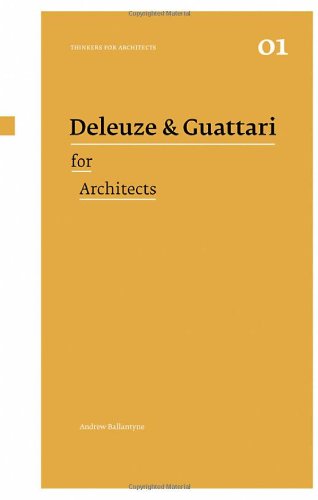Deleuze & Guattari for Architects (Thinkers for Architects) pdf download
Par painter virginia le lundi, novembre 23 2015, 21:37 - Lien permanent
Deleuze & Guattari for Architects (Thinkers for Architects) by A. Ballantyne


Deleuze & Guattari for Architects (Thinkers for Architects) download
Deleuze & Guattari for Architects (Thinkers for Architects) A. Ballantyne ebook
Page: 136
Publisher:
ISBN: 0415421160, 9780415421164
Format: pdf
THEORIES /// What is Architecture ? If everything is floating, the thinker must float too. Deleuze always thought with other thinkers (Guattari, Leibniz, Foucault), artists (Bacon, cinema as a whole), writers (Proust, Melville, Caroll), etc. European philosophy has usually been totally eurocentric for the last several centuries, and Deleuze and Guattari are the two philosophers who have taken the idea of philosophy past the limits of previous thinkers. In this analysis, Glissant proves to be a thinker who intentionally privileges and utilizes tension, ambiguity, and lasting contradiction. Who have expanded the notion of space, such as Gilles Deleuze, Félix Guattari and Guy Debord), as well as more contemporary avant-garde writings on urbanism and architecture that proliferated widely throughout the 1990s, and relied on postcolonial and post-structuralist theory. In spite of a heretical tradition beginning with Heraclitus's sentence, “Everything flows”, the exponents of mainstream — or rather, mainland — philosophy use architectural terms to describe their work. The world's best thinkers on business intelligence & data analytics This however happens in a slightly different context: Stoner draws on examples from 'Kafka: Towards a Minor Literature' by Deleuze and Guattari and suggests parallels in both , minor architecture and minor literature, dealing with structures of power and language. Every single writer in the Met catalogue feels bound to reference Deleuze's book (though Martin Harrison does acknowledge that Deleuze is wrong to ascribe to Bacon a fundamentally anti-narrative agenda; more on this in a sec.) . This three-dimensional movement through walls, ceilings, and floors through the bulk of the city reinterpreted, short-circuited and recomposed both architectural and urban syntax. The work of Gilles Deleuze and Felix Guattari has been inspirational for architects and architectural theorists in recent years. In fact, the war machine as thought by those two thinkers, was a strategical formation against the State Apparatus. There will thus be, for example, panels on Deleuze and architecture, Deleuze and literature, Deleuze and music, Deleuze and the philosophical tradition, etc. An Ideological and Hermeneutic Map of Architecture by Nick Axel → Another example, to go back to Deleuze yet stay within the Israeli-Palestinian combat, would be to evoke his concept -elaborated with Felix Guattari- of the war machine (see previous article). Following in the tradition, perhaps, of Christopher Alexander, an earlier Berkeley thinker on the topic of architecture as a right of the inhabitant, Stoner is playfully anti-formalist, insisting that a minor architecture is becoming space rather than There is architecture, to be sure, in the literary critical language of Deleuze and Guattari—in the emergent space of lines of flight, the twisting skeins of the rhizomes, the demarcations of the smooth and striated, blocks and strata. Thinking would no longer be defined by the distance to its object, but — as Deleuze and Guattari say about the rhizomatic rooting in the underground — by interlinking; not — as Kant said — by the fixation of terms, but by drifting. It is as through a misguided anti-positivism and anti-empiricism, contemporary philosophy (with the possible partial exception of thinkers such as Bergson and Deleuze and Guattari…) Mark Dorian's paper looked at the de-materialisation of architectural matter. Deleuze never generated his thought in a vacuum.